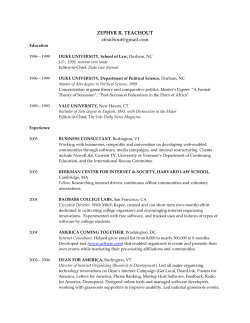
Economic Growth and the Dynamics of Healthcare Systems by Dr
Economic Growth and the Dynamics of Health Care Systems: The Experience of Three East-Asian Countries and Implications for China’s Health Care Reform Chee-Ruey Hsieh (谢启瑞) Professor of Health Economics Duke Global Health Institute & Global Health Research Center, Duke Kunshan University COPYRIGHT © 2014 DUKE KUNSHAN UNIVERSITY. Decision Analysis at Individual and Firm Levels Demand Side (Part I) Demand for Health and Health Behavior (2) Demand for Health Care (3) Demand for Health Insurance (4) Supply Side (Part II) Physician Firms (5) Quality (7) Hospitals (6) Nurses (8) Pharmaceutical Firms (9) Private Insurer Firms (10) System Analysis at Market Level (Part III) Cash System and Private System (11) Semi-Public System (12) Public-System (13) Performance of Health Care Sector: Positive and Normative Aspects (Part IV) Cost-Effectiveness Analysis (14) Cost-Benefit Analysis (15) The Link Between Health and Economic Sector (16) Frontiers of Health Economics (17) Fig. 1.6. Health Economics Roadmap . Health Systems: Two Dimensions Is financing private or public? Is provision of services private or public? Countries differ in both dimensions. COPYRIGHT © 2014 DUKE KUNSHAN UNIVERSITY. The Relationship between Public Financing Share and Public Supply Share Share of Public Supply (%) Norway Denmark Finland United Kingdom Poland 100 Canada Turkey 90 Czech Republic 80 Portugal Italy Mexico 70 Greece Spain France New Zealand Austria 60 50 Germany Australia 40 United States 30 Japan Taiwan 20 10 Korea 0 0 10 20 30 40 50 60 70 Share of Public Financing (%) 80 90 100 Four Quadrants in country health system classification scheme Quadrant I: High on public financing from general tax revenue and from ear-market payroll taxes and high on public provision (hospital provision): Great Britain; Canada; Scandinavian countries Quadrant II: High public provision, but largely privately financed (high share of patient out-of-pocket payments=“cash systems”): India and many low-income countries Quadrant III: High shares of private financing (largely out of private health insurance) and private provision: U.S. Quadrant IV: Public financing (often public single payer) and private provision: Germany; Japan; South Korea; Taiwan among others.. COPYRIGHT © 2014 DUKE KUNSHAN UNIVERSITY. Does the Health System Change Over Time? The answer is “no” for some countries, such as UK and Germany. Their systems remain almost constant for more than half century or even a century. However, the answer is “yes” for other countries with rapid economic growth, such as South Korea, Taiwan and China. COPYRIGHT © 2014 DUKE KUNSHAN UNIVERSITY. Why Economic Growth Leads to a Change in Health System? High income increases the capacity of the government to increase the investment on health care which in turn increases the share of public financing. COPYRIGHT © 2014 DUKE KUNSHAN UNIVERSITY. Percentage of population with health insurance in Taiwan between 1950 and 2000 Percent of insured population (%) 100 90 80 70 60 50 40 30 20 10 0 1950 1956 1961 1966 1971 1976 1981 1986 1991 1996 Implementation of LI FHI was introduced Implementation of GEI COPYRIGHT © 2014 DUKE KUNSHAN UNIVERSITY. Year FHI phased in Implementation of NHI Trends in the Out‐of‐Pocket (OOP) Share in Japan and other East Asian Countries Source: Wagstaff (2007) The Relationship between Share of Public Financing and Share of Health Expenditures from Out‐of –Pocket Payments 70 % of out-of-pocket payment 60 MEX 50 40 KOR SUI 30 POL HUN ESP POR ITA BEL ISL FIN NZL AUS DEN NOR AUT CAN JPN GER IRL 20 USA 10 NED FRA CZE LUX 0 30 40 50 60 70 Source: OECD Health Data (2008) 80 90 100 % of public financing The Relationship between GDP Per Capita and the Public Financing Share Y (Log of Share of Public Financing,%) 5 Y=3.07+0.12X R-Square=0.22 N=166 4 3 2 4 5 6 7 8 9 10 X (Log of GDP Per Capita in 2000 US dollar) 11 Source: Public financing share is from 2006 the World Health Report; GDP per capita is from 2007 World Development Indicators (Sample Size=166); and the regression line is calculated by authors. Why Economic Growth Leads to a Change in Health System? • High income increases the demand in health care, indicating an increase in the size of health care market, which in turn induces the entry of new hospitals or the expansion of the existing hospitals. • Private firms are more responsive to public firms. As a result, the share of private supply increases over time. COPYRIGHT © 2014 DUKE KUNSHAN UNIVERSITY. Question in the individual level: What do you plan to do when you become rich? COPYRIGHT © 2014 DUKE KUNSHAN UNIVERSITY. The Answer from Economic Analysis As people get richer and consumption rises, the marginal utility of consumption falls rapidly. Spending on health to extend life allows individuals to purchase additional periods of utility. The marginal utility of life extension does not decline. As a result, the optimal composition of total spending shifts toward health, and the health share grows along with income. In projections based on the quantitative analysis of our model, the optimal health share of spending seems likely to exceed 30 percent by the middle of the century. Hall, R. E. and C. I. Jones (2007). "The Value of Life and the Rise in Health Spending." Quarterly Journal of Economics 122(1): 39-72. COPYRIGHT © 2014 DUKE KUNSHAN UNIVERSITY. The Story of Chinese Empire Seeking for Elixir Qin Shi Huang united 6 kingdoms and became the very first emperor of ancient China in 221 B.C. Right after two years later, he sent Xu Fu, a diviner, with ships carrying hundreds of boys and girls in quest of the legendry elixir of life. But Xu Fu never came back. Then several other teams were sent for the same goal, but Qin Shi Huang never got the elixir. Take Home Message People are willing to pay more relative to other consumption goods to be in good health when they become more affluent. COPYRIGHT © 2014 DUKE KUNSHAN UNIVERSITY. The Relationship between Share of GDP Spent on Health Care and GDP Per Capita Share of GDP spent on health care 16 USA 14 12 FRA SUI BEL 10 GRE NZL HUN 8 SVK MEX ESP ITA DEN SWE FIN JPN CAN ISL NED AUS GBA NOR IRL LUX CZE POL 6 AUT GER POR KOR TUR 4 5000 10000 15000 20000 25000 30000 35000 Source: OECD Health Data (2008) 40000 45000 50000 55000 GDP per capita(unit: US dollar) Who hear the people’s voice? Market (private sector) or government (public sector)? COPYRIGHT © 2014 DUKE KUNSHAN UNIVERSITY. The Evolution of Health Care System in Taiwan, 1950-2000 COPYRIGHT © 2014 DUKE KUNSHAN UNIVERSITY. How about China? COPYRIGHT © 2014 DUKE KUNSHAN UNIVERSITY. Share of Out‐of‐Pocket (OOP) Cost in Health Care Financing, 1978‐2010 Ownership Structure of Hospitals in China 20052012 (in terms of number of hospitals) COPYRIGHT © 2014 DUKE KUNSHAN UNIVERSITY. Ownership Structure of Hospitals in China 20052012 (in terms of number of hospital beds) COPYRIGHT © 2014 DUKE KUNSHAN UNIVERSITY. Summary • Economic growth seems bringing a convergence of the health care systems across middle-income or newly industrial countries. • Economic growth leads to an increase in share of public financing and an increase in the share of private supply. • As the result, the system moves toward quasi-public system (or social insurance system), a system with higher share of public financing and a higher share of private supply. COPYRIGHT © 2014 DUKE KUNSHAN UNIVERSITY. Major Characteristics of Quasi-Public System Government or public payer steps in to set the regulated prices Private providers account for a larger share of market, they compete each other on a non-price basis. Payment system is based on the quantity of services instead of quality. COPYRIGHT © 2014 DUKE KUNSHAN UNIVERSITY. The composition structure of hospital revenues in Sichuan province, China, 2002-2012 COPYRIGHT © 2014 DUKE KUNSHAN UNIVERSITY. The average size of hospitals and the market share of tertiary and secondary hospitals in outpatient / inpatient visits in China, 2002-2012 COPYRIGHT © 2014 DUKE KUNSHAN UNIVERSITY. Policy Challenges Arising from the Dynamic Change of Health Care System in China Payment system: How to pay physicians and hospitals? Quality of Health Care: How to design a payment system to reward the good quality of health care? COPYRIGHT © 2014 DUKE KUNSHAN UNIVERSITY. Question and Answer
© Copyright 2025









